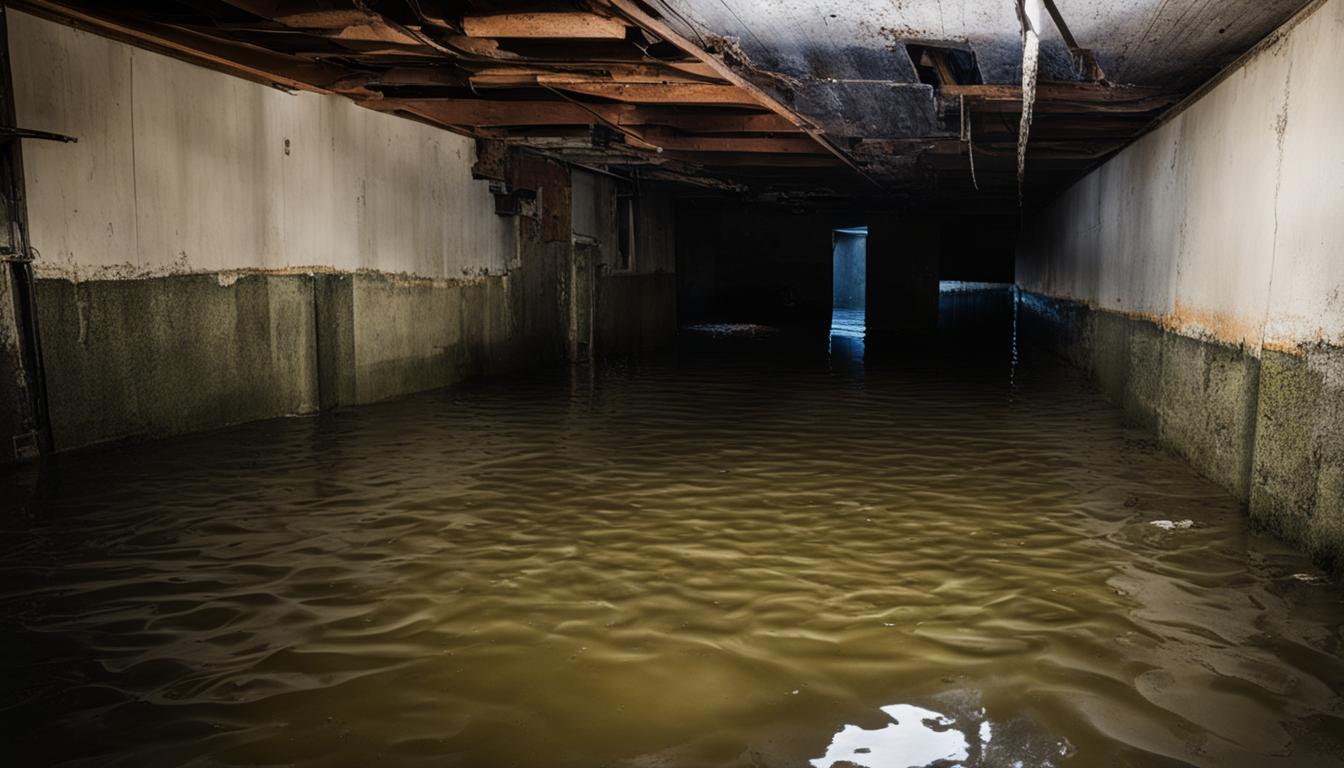Have you ever thought about if a wet basement can be fixed? Or if it’s just something homeowners have to deal with? A wet basement is more than a simple annoyance. It can cause mold, bad smells, damage to your property, and even harm your home’s structure. But, there are solutions that can fix both the short-term and long-term problems.
First, find out why water is getting in, like leaks or groundwater. Then, take steps to stop the water, like pumping it out and controlling moisture. Using good drainage and sump pumps is key to fixing foundation damage and keeping moisture away. These steps help keep your basement dry and safe from water issues in the future.
Key Takeaways
- Recognizing the severity of a wet basement, including potential mold and structural damage.
- Immediate actions for wet basement solutions, such as water extraction and moisture management.
- Understanding common causes like subsurface groundwater and plumbing leaks.
- Effective drying methods to aid in basement waterproofing.
- Sustainable, long-term strategies to prevent future water infiltration.
Immediate Actions to Take When Your Basement is Wet
Act fast if your basement floods to lessen damage and protect health. Here are important steps to follow:
- Avoid contact with wet electrical devices to ensure safety.
- Identify the water source – it could be a plumbing issue or persistent seepage.
- Remove standing water promptly using a wet-dry vacuum for basements, or call professionals for larger amounts.
- Dry or discard items prone to mold such as paper, fabric, wood, and leather to prevent mold risk.
- Consider partial replacement solutions for water-damaged walls.
These quick steps help in preventing further damage and mold growth.
Common Causes of Basement Water Problems
Knowing why basements get wet can help stop big damage and costly fixes. Many things cause moisture in basements. These can be split into surface water and underground water problems.
Hydrostatic pressure is a big reason for basement water issues. It pushes water through the concrete, causing foundation cracks and basement seepage. Also, bad surface water drainage can make water gather around the foundation, making things worse.
Here are some surface water issues that add to basement moisture:
- Gutter overflow from clogged or broken gutters can spill water down the house sides, near the foundation.
- Landscaping that slopes towards the foundation can bring water closer to the house.
- Leaks in basement windows and clogged window wells let water in during heavy rains.
- Downspouts that are too short don’t move water far enough from the foundation, causing moisture issues.
Sometimes, big problems like plumbing failures or storm sewer backups cause big basement floods. These need special fixes, like a sump pump or exterior drainage tile work, to keep water away.
Steps for Drying Out a Wet Basement
Drying a wet basement needs a detailed plan. It’s about improving air flow and getting rid of moisture. Here are the key steps to make sure your basement stays dry.
- Enhance Air Circulation: Use fans to improve airflow. Place portable fans in the basement to spread out humid air and help dry the area.
- Basement Dehumidification: Get a dehumidifier to lower humidity. These devices pull out extra moisture from the air, which is key for controlling humidity.
- Temperature Adjustments: Change the temperature to stop condensation. In cold months, heating the basement stops moisture from forming on walls and floors, helping with humidity control.
- Seal Entry Points: Seal any spots where water might get in. Use hydraulic cement or polyurethane caulk to close up cracks and gaps in the basement walls.
- Install Moisture Barriers: Put moisture barriers on walls and floors. These barriers keep moisture from getting inside the basement.
- Waterproof Coatings: Coat basement walls with waterproof products. These coatings create a strong layer that stops water from getting in.
- Improve Landscape Grading: Make the landscape around the foundation slope right. This ensures water flows away from the foundation, reducing the chance of water gathering near the basement.
These steps help solve current problems and keep your basement healthy in the long run. By boosting air flow, using dehumidifiers, and applying moisture barriers and waterproof coatings, you can manage humidity and keep your basement dry and welcoming.
Can a Wet Basement Be Fixed?
Fixing a wet basement can be simple or complex. Sometimes, just rerouting downspouts, sealing wall gaps, and reshaping the land can help. These steps can greatly cut down on water and moisture.
For ongoing problems, more serious steps might be needed. This could mean fixing or putting in new footing drains, using curtain drains, or even doing major excavation for waterproofing outside. Getting a detailed check-up is key in these situations.
It’s smart to work with foundation waterproofing experts for tough or recurring issues. They can give a full check-up and recommend the best steps. They also offer affordable fixes that fit your basement’s specific needs.
The cost and what’s needed depend on how bad the water problems are and their cause. Whether it’s simple fixes or full waterproofing, getting a dry basement usually means a mix of expert advice and practical steps.
Avoiding Future Basement Water Problems
To keep your basement dry, it’s important to take steps now. Start with regular basement maintenance. Check and fix gutters, downspouts, and sump pumps often. Make sure your sump pump works well to remove extra water.
Watch the moisture levels with moisture monitoring. Use a hygrometer to keep an eye on humidity. Adjust your dehumidifier to stop mold and moisture problems. This is key to preventive basement waterproofing.
Don’t forget about your yard. Good landscape management helps keep water away from your basement. Make sure your yard drains well. Consider a rain garden or dry well for heavy rain.
Getting advice from waterproofing experts is smart. They can suggest the best ways to protect your home. Fix any problems quickly to stop water issues from coming back. Taking care of your basement early saves time and money later.
Conclusion
Homeowners facing basement water issues can find relief with the right methods and resources. By addressing immediate threats and understanding common causes, a wet basement can become dry and usable. Proper drying techniques play a key role in this transformation.
Long-term waterproofing strategies are crucial for preventing basement water damage. This includes maintaining drainage systems, applying sealants, and using sump pumps if needed. Regular maintenance and watching closely are key to keeping a basement dry and protecting your home’s value.
Getting help from professional waterproofing services adds extra confidence that moisture problems are fully solved. These experts provide solutions that fix current issues and prevent future ones. This ensures your basement stays dry and your home’s value stays high.
Being proactive and taking informed steps leads to a lasting fix for basement water problems. It shows that keeping a basement dry is both possible and important for homeowners.









